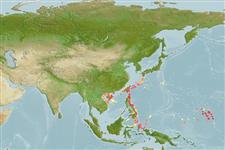>
Ovalentaria/misc (Various families in series Ovalentaria) >
Plesiopidae (Roundheads) > Acanthoclininae
Etymology: batanensis: Named after its type locality, Batan Island.
Environment: milieu / climate zone / depth range / distribution range
Οικολογία
Θαλασσινό(ά) βενθικό(ς); εύρος βάθους 9 - 12 m (Ref. 40821). Tropical
Western Central Pacific: known only from northern Philippines. Possibly occurring in Taiwan.
Μέγεθος / Βάρος / Age
Maturity: Lm ? range ? - ? cm
Max length : 2.4 cm TL αρσενικό/απροσδιόριστο; (Ref. 90102)
Ραχιαίες άκανθες (συνολικά) : 20; Μαλακές ραχιαίες ακτίνες (συνολικά) : 2; Εδρικές άκανθες: 11; Μαλακές εδρικές ακτίνες: 2; Σπόνδυλοι: 27. Posterior body scales with membranous flaps and ctenii, if present, very reduced, short and robust dorsal-and anal-fin spines, and the interradial membranes of the spinous dorsal fin weakly incised.
Eggs are guarded by the male parent (Ref. 205).
Life cycle and mating behavior
Γεννητική Ωρίμανση | Αναπαραγωγή | Γεννοβολία | Αβγά | Γονιμότητα | Προνύμφες
Eggs are guarded by the male parent (Ref. 205).
Smith-Vaniz, W.F. and G.D. Johnson, 1990. Two new species of Acanthoclininae (Pisces: Plesiopsidae) with a synopsis and phylogeny of the subfamily. Proc. Acad. Nat. Sci. Philad. 142:211-260. (Ref. 40821)
IUCN Red List Status (Ref. 130435: Version 2024-2)
Threat to humans
Harmless
Human uses
Εργαλεία
Special reports
Download XML
Διαδικτυακές πηγές
Estimates based on models
Preferred temperature (Ref.
123201): 24.9 - 29.2, mean 28.7 °C (based on 455 cells).
Phylogenetic diversity index (Ref.
82804): PD
50 = 0.7500 [Uniqueness, from 0.5 = low to 2.0 = high].
Bayesian length-weight: a=0.00457 (0.00175 - 0.01195), b=3.11 (2.88 - 3.34), in cm total length, based on LWR estimates for this (Sub)family-body shape (Ref.
93245).
Τροφικό Επίπεδο (Ref.
69278): 3.1 ±0.5 se; based on size and trophs of closest relatives
Ελαστικότητα (Ref.
120179): Υψηλό, ελάχιστος χρόνος για διπλασιασμό πληθυσμού < 15 μήνες (Preliminary K or Fecundity.).
Fishing Vulnerability (Ref.
59153): Low vulnerability (10 of 100).
